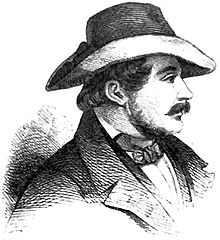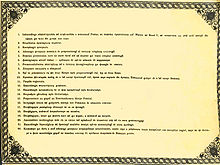Ion Heliade-Rădulescu
Ion Heliade-Rădulescu (born January 6, 1802 in Târgovişte , † April 27, 1872 in Bucharest ) was a Romanian writer , philosopher , linguist , translator and politician , also co-founder and first president of the Romanian Academy (Academia Română) .
biography
The son of the wealthy landowner Ilie Rădulescu and his wife Eufrosina Danielopol received Greek lessons at an early age. After 1813 Rădulescu became a pupil of the orthodox monk Naum Ramniceanu, in 1815 switched to the Greek school “Schitu Măgureanu” in Bucharest, then in 1818 to the college “Sfântul Sava”, where Gheorghe Lazăr also taught him. After graduating, he taught arithmetic and geometry there as a substitute teacher. During this time he took the surname "Heliade" instead of Rădulescu, which, as he later explained, was a Greek version of his patronymic , which resulted from the Romanian version of "Ilie".
After Gheorghe Lazăr became seriously ill in 1822 and the "Sfântul Sava" college was closed, Heliade reopened it and served as his most important teacher, initially without any form of remuneration. He was later assisted in this endeavor by other intellectuals such as Eufrosin Poteca and eventually opened an art class as well. This re-establishment came as a result of a decree by the newly appointed Prince Grigore IV. Ghica , who also approved the instruction in Romanian.
Heliade was increasingly involved in cultural policy. In 1827, he and Dinicu Golescu the "Soţietatea literară Românească" ( "Romanian Society of Literature"), the conversion of "Sfântul Sava" was suggested in a university in the program and the opening of another such institution in Craiova and the establishment from schools in almost all localities of the Walachae . In addition, the company tried to promote the edition of Romanian-language newspapers and demanded an end to the state monopoly on printing machines. The group benefited from Golescu's experiences abroad, then two future princes Gheorghe Bibescu and Barbu Dimitrie Știr joined the organization, whose character was based on the principles of Freemasonry . The head office was at Podul Mogoşoaiei in Bucharest.
In 1828 Heliade published the "Gramatica Românească" in Sibiu , where the author proved to be a reformer of the language. He supported the simplification of the Cyrillic alphabet, the phonetic spelling and the borrowing of neologisms from Latin and other Romance languages.
April 8th July / April 20, 1829 greg. together with Dinicu Golescu, who also took care of the finances, he had the "Curierul Românesc" printed, the first magazine in Romanian in the Romanian principalities. Soon afterwards he began to translate, including by Alphonse de Lamartine , and he also wrote and poetry more and more.
With Prince Alexandru II Ghica's accession to the throne in 1834, Heliade became one of his closest collaborators, quickly rose to the rank of court and also referred to himself as a “court poet”. He also became director of the School of Singing, Lecturing and Literature, which was designed to train professional actors. When young reformers came into conflict with the prince, he remained neutral, arguing that all parties involved represented a privileged minority and called for moderation. Even before Prince Ghica was replaced by Gheorghe Bibescu , Heliades relations with the latter had deteriorated. In contrast to his earlier appeals, the writer decided to go with the liberal current and their conspiratorial resistance to Bibescu, especially after the deal between him and the businessman Alexander Trandafiloff regarding mining rights.
Ion Heliade played a pivotal role during the revolution of 1848 . The Islaz proclamation on June 13th jul. / June 25, 1848 greg. , the programmatic document of the Wallachian Revolution, was drawn up and presented by him. He then became a member of the Provisional Government as Minister of Education, his generally conciliatory stance creating an opposition among the ranks of the more radical leaders. They were particularly angry about his approval of the pre-revolutionary constitution and his support for Ottoman rule. After the suppression of the uprising, the man of letters went into exile and became the leader of those who favored maintaining the suzerainty of the gate as a defense of the Romanian lands against further Russian advance. Because of this, he was in constant conflict with the other major emigration leaders, such as Nicolae Bălcescu , CA Rosetti and the Brătianu and Golescu brothers. On the other hand, he made constant contributions to major democratic publications in Paris such as "Le Siècle", "La Semaine", "La Presse" or "L'Europe et Amerique" and maintained relationships with leading French personalities such as Pierre-Joseph Proudhon and Élias Regnault . Both should help the Romanian cause in the years to come.
After the evacuation of Russian troops from the Danube Principalities during the Crimean War , Heliade was appointed by the Porte to collaborate with Omar Pasha to represent the Romanian nation in the negotiations of the Peace of Paris in 1856. His repeated expression of sympathy for the Ottoman Empire was rewarded with the title of Bey . Later that year he decided to return to Bucharest, but his stay was short-lived after the Austrian authorities, who, under the leadership of Johann Baptist Graf von Coronini-Cronberg , had taken over the administration of the state as a neutral force, asked him to to leave the country. He returned to Paris, where, in addition to the publication of new works, he caused a sensation with his own translation of the Septuagint .
After the unification of the Romanian principalities under the leadership of Alexandru Ioan Cuza , he returned to Bucharest and made "Rădulescu" part of his surname again. In 1863 Prince Cuza provided him with an annual annuity of 2,000 lei. In the elections of 1866, Heliade Rădulescu won a seat in the Chamber as MP for the city of Târgovişte. When Cuza was ousted from power by a coalition of various political groups and Karl von Hohenzollern-Sigmaringen was to be installed as ruler, he was one of the few opponents of this project.
Heliade co-founded the National Theater of Bucharest, together with Costache Aristia and Ion Câmpineanu , which opened its doors on December 31, 1852. One year after the founding of the Romanian Academy under the name "Societatea Academică Romînă" he was elected its first president in 1867 and held this office until his death in 1872.
Works
prose
- Prologue la serbarea numelui preaînălţatului nostru domn Alexandru D. Ghica 1835 aug. 30th
- Dispoziţiile şi încercările mele de poezie
- Gheorghe Lazar
- Bată-te Dumnezeu! (Coconiţa Drăgana)
- Coconul Dragan
- Fata lui Chiriac
Poems
- Sonet la anul 1830
- Epigramă
- Elegy I. Trecutul
- Elegy II. Dragele mele umbre
- Cântarea dimineţii
- Sonet
- La moartea lui Cârlova
- Serafimul şi heruvimul sau Mângâierea conştiinţei şi mustrarea cugetului
- Portrait
- Adio la anul 1832
- Destăinuirea
- Visul
- O noapte pe ruinele Târgoviştii
- Odă asupra aniversării de 2 sept. 1829
- Odă la pavilionul grecesc
- La un poet exilat
- Calul, vulpea, lupul
- Epitafe
- Cumetria cioarei când sa numit privighetoare
- La Elvira
- Cutremurul
- Ingratul
- Vulturul şi bufa
- Zburătorul
- Mihaida
- Epitaf la o femeie cochetă
- În aşteptarea lui 1848. Preziua. psalm
- Sânta cetate (Terţa rima)
- La Schiller
- Dulcamara
- Muştele şi albinele
- Corbul şi Vulpea
- Areopagul bestiilor
- Un muieroi şi o femeie
- Mircea şi Lazar
- Poezia
- Adio la patrie
- La Maria
- Primul baciu
- Un book de mireasa
- Portretul
- Anatolida sau Omul şi forţele
Translations
- Suvenirul de Alphonse de Lamartine
- Războiul de Alphonse de Lamartine
- Corbul şi vulpea de Jean de La Fontaine
- Singurătatea de Alphonse de Lamartine
- Seara de Alphonse de Lamartine
- Lacul de Alphonse de Lamartine
- Toamna de Alphonse de Lamartine
- Imnul nopţii de Alphonse de Lamartine
- Romanţă de George Gordon Byron (Lord Byron)
- Poema didactică după Boileau şi Horaţiu de Nicolas Boileau
- Cântarea dracilor în preziua potopului de George Gordon Byron (Lord Byron)
- Depărtarea de Paolo Antonio Rolli
- Foile şi cărbunele de P. Viennet
- Coada momiţelor de P. Viennet
- La amanta de Sappho
- Margherita de A. Dumas
- Lament amoros de Iacopo Vittorelli
- Poetul murind de Alphonse de Lamartine
- Cavalerul Toggenburg de Friedrich Schiller
- Arpa lui David de George Gordon Byron (Lord Byron)
literature
- Theodor Stănescu-Stanciu: "Şi Heliade a fost îndrăgostit", in "Istoric Magazine", December 2000
- Constantin C. Giurescu: “Istoria Bucureştilor. Din cele mai vechi timpuri pînă în zilele noastre “, Editura Pentru Literatură, Bucharest 1966
- Frederick Kellogg: "The Road to Romanian Independence", Purdue University Press, West Lafayette 1995 ISBN 1-55753-065-3
- Nicolae Iorga: "Histoire des relations entre la France et les Roumains", Payot & Cie publishing house, Paris 1918
Individual evidence
- ↑ http://tratatuldeistorieamasoneriei.ro/ilustiri_fm.html
- ↑ a b Theodor Stănescu-Stanciu: “Şi Heliade a fost îndrăgostit”, in “Magazin Istoric”, December 2000, p. 67 ff
- ↑ a b c d Constantin C. Giurescu: “Istoria Bucureştilor. Din cele mai vechi timpuri pînă în zilele noastre “, Editura Pentru Literatură, Bucharest 1966, p. 120
- ↑ Constantin Măciucă: "Prefaţă", "Tabel cronologic", pp. V – XL, here pp. VII, X, XXXVII f
- ↑ Wendy Bracewell, Alex Drace-Francis (Ed.): "Balkan Departures - Travel Writing from South-Eastern Europe", Berghahn Books, USA 2009, p. 54
- ↑ Constantin Maciuca "Prefaţă", "Tabel cronologic" p V-XL, here p XXXVIII
- ↑ http://www.ohio.edu/chastain/dh/heliad.htm
- ↑ Constantin Maciuca "Prefaţă", "Tabel cronologic" p V-XL, here p XXXIV
- ↑ Frederick Kellogg: "The Road to Romanian Independence", Purdue University Press, West Lafayette 1995, p. 22 f
- ^ Roger Bauer, Michael de Graat, Jürgen Wertheimer: "Yearbook for international German studies: Congress reports", volumes 18-19, Verlag Peter Lang, 1986, p. 342
- ↑ http://www.art-zone.ro/poezii/ion_Heliade_radulescu.htlm ( page no longer available , search in web archives ) Info: The link was automatically marked as defective. Please check the link according to the instructions and then remove this notice.
Web links
| personal data | |
|---|---|
| SURNAME | Heliade-Rădulescu, Ion |
| ALTERNATIVE NAMES | Heliade, Ion; Rădulescu, Ion; Ion Heliade-Rădulescu (full name) |
| BRIEF DESCRIPTION | Romanian writer philosopher and politician |
| DATE OF BIRTH | January 6, 1802 |
| PLACE OF BIRTH | Târgovişte |
| DATE OF DEATH | April 27, 1872 |
| Place of death | Bucharest |





